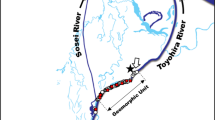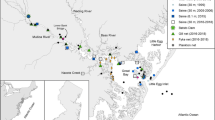Abstract
Spawning densities, spawning indices, egg densities, size distributions, and movement patterns of horseshoe crabs (Limulus polyphemus) were quantified for four coastal embayments (Monomoy National Wildlife Refuge, Pleasant Bay, Nauset Estuary, and Cape Cod Bay) on Cape Cod, Massachusetts from 2000 to 2002. Spawning activity was highest from mid May through mid June, but densities varied throughout the Cape Cod region. Average spawning densities (male and female crabs combined), measured using 25-m2 quadrats, were lower than 1 crab 25 m−2, although certain locations had consistently higher densities averaging 2 to 3 crabs 25 m−2 with individual survey densities recorded as high as 17 crabs 25 m−2. Spawning densities during night surveys were either similar or slightly higher than day surveys, except at a few sites within Pleasant Bay. Spawning indices were considerably lower ranging from 0 to 1.3 females 25 m−2 throughout the Cape Cod region. Spawning sex ratios varied from 1∶1.6 to 1∶3.1 (females:males) throughout the region, except within Pleasant Bay where highly male skewed ratios were observed (e.g., 1∶5.8, 3-yr average). Egg densities were low overall (<1 egg cm−2) throughout Cape Cod and egg densities tended to be higher in deeper sediments (5–20 cm deep) compared to shallow sediments (0–5 cm deep) at most locations. Over 7,800 horseshoe crabs were tagged on Cape Cod from 2000 to 2002. Average size and size frequency distributions of tagged crabs varied among regions. Larger individuals were observed at Monomoy National Wildlife Refuge while the smallest individuals were from Cape Cod Bay. We documented an overall recapture rate of 6.7% and our tag-recapture data indicated that 62% of crabs were recaptured at the original tagging location and 70% of recaptures traveled less than 2 km from the original tagging location, providing evidence for localized populations on Cape Cod. We have observed that horseshoe crabs differ among embayments within a regional area, suggesting the potential need for management plans specific to embayments or subregions depending on the characteristics of a population.
Similar content being viewed by others
Literature Cited
Atlantic Marine States Fisheries Commission (ASMFC). 1998. Interstate fishery management plan for horseshoe crab. Atlantic Marine States Fisheries Commission, Fishery Management Report No. 32. Washington, D.C.
Badgerow, J. P. andM. A. Sydlik. 1989. Nest site selection in horseshoe crabs (Limulus polyphemus) using a Cape Cod beach.American Zoologist 29:36.
Baptist, J. P., O. R. Smith, and J. W. Ropes. 1957. Migrations of the horseshoe crab,Limulus polyphemus, in Plum Island Sound, Massachusetts. U.S. Fish and Wildlife Service, Special Scientific Report—Fisheries No. 220. Washington, D.C.
Barlow, Jr.,R. B., M. K. Powers, H. Howard, andL. Kass. 1986. Migration ofLimulus for mating: Relation to lunar phase, tide height, and sunlight.Biological Bulletin 171:310–329.
Berkson, J. andC. N. Shuster, Jr. 1999. The horseshoe crab: The battle for a true multiple-use resource.Fisheries 24:6–10.
Botton, M. L. 1982. Predation by adult horseshoe crabsLimulus polyphemus (L.), and its effect on benthic community structure of breeding beaches in Delaware Bay, New Jersey. Ph.D. Dissertation, Rutgers University, New Brunswick, New Jersey.
Botton, M. L. 1995. Horseshoe crab, p. 51–57.In L. E. Dove and R. M. Nyman (eds.), Living Resources of the Delaware Estuary. The Delaware Estuary Program, Dover, Delaware.
Botton, M. L. andR. E. Loveland. 2003. Abundance and dispersal potential of horseshoe crab (Limulus polyphemus) larvae in the Delaware estuary.Estuaries 26:1472–1479.
Botton, M. L., R. E. Loveland, andT. R. Jacobsen. 1988. Beach erosion and geochemical factors: Influence on spawning success of horseshoe crabs (Limulus polyphemus) in Delaware Bay.Marine Biology 99:325–332.
Botton, M. L., R. E. Loveland, andT. R. Jacobsen. 1994. Site selection by migratory shore birds in Delaware Bay, and its relationship to beach characteristics and abundance of horseshoe crab (Limulus polyphemus) eggs.The Auk 111:605–616.
Botton, M. L. andJ. W. Ropes. 1987. Populations of horseshoe crabsLimulus polyphemus, on the northwest Atlantic continental shelf.Fisheries Bulletin 85:805–812.
Brockmann, H. J. 1990. Mating behavior of horseshoe crabs,Limulus polyphemus.Behavior 114:206–220.
Carmichael, R. H., D. Rutecki, B. Annett, E. Gaines, andI. Valiela. 2003a. Position of horseshoe crabs in estuarine food webs: N and C stable isotopic study of foraging ranges and diet composition.Journal of Experimental Biology and Ecology 299:231–253.
Carmichael, R. H., D. Rutecki, andI. Valiela. 2003b. Abundance and population structure of the Atlantic horseshoe crabLimulus polyphemus in Pleasant Bay, Cape Cod.Marine Ecology Progress Series 246:225–239.
Castro, G. andJ. P. Meyers. 1993. Shorebird predation on eggs of horseshoe crabs during the spring stopover in Delaware Bay.The Auk 110:927–930.
Castro, G., J. P. Myers, andA. Place. 1989. Assimilation efficiency of sanderlings (Calidris alba) feeding on horseshoe crab (Limulus polyphemus) eggs.Physiological Zoology 62:716–731.
Clark, K. E. 1996. Horseshoe crabs and the shorebird connection, p. 23–25.In J. Farrell and C. Martin (eds.), Proceedings of the Horseshoe Crab Forum: Status of the Resource. Publication No. DEL-SG-05-97. University of Delaware Sea Grant College Program, Lewes, Delaware.
Clark, K. E., L. J. Niles, andJ. Burger. 1993. Abundance and distribution of migrant shorebirds in Delaware Bay.Condor 95:694–705.
James-Pirri, M. J., K. Tuxbury, S. Marino, and S. Koch. 2002. Population Demographics and Spawning Densities of the Horseshoe Crab,Limulus polyphemus, within Cape Cod National Seashore, Cape Cod Bay, and Monomoy National Wildlife Refuge, Massachusetts. Department of the Interior, National Park Service, Boston Support Office, Technical Report NPS/BSO-RNR/NRTR/2002-12. Boston, Massachusetts.
King, T. L., M. S. Eackles, A. P. Spidle, and H. J. Brockmann. 2004. Regional differentiation and sex-biased dispersal among populations of the horseshoe crab (Limulus polyphemus). Final Report to the U.S. Geological Survey, Study Plan #02065-01. Kearneysville, West Virginia.
Kurz, W. T. andM. J. James-Pirri. 2002. The impact of biomedical bleeding on horseshoe crab,Limulus polyphemus, movement patterns on Cape Cod, Massachusetts.Marine and Freshwater Behaviour and Physiology 35:261–268.
Michels, S. F. 1996. Summary of trends in horseshoe crab abundance in Delaware, p. 26–29.In J. Farrell and C. Martin (eds.), Proceedings of the Horseshoe Crab Forum: Status of the Resource. Publication No. DEL-SG-05-97. University of Delaware Sea Grant College Program, Lewes, Delaware.
Novitsky, T. J. 1984. Discovery to commercialization: The blood of the horseshoe crab.Oceanus 27:19–26.
O’Connell, C. W., S. P. Grady, A. S. Leschen, R. H. Carmichael, andI. Valiela. 2003. Stable isotopic assessment of site loyalty and relationships between size and trophic position of the Atlantic horseshoe crab,Limulus polyphemus, within Cape Cod Estuaries.Biological Bulletin 205:254–255.
Pierce, J. C., G. Tan, andP. M. Gaffney. 2000. Delaware Bay and Chesapeake Bay populations of the horseshoe crab (Limulus polyphemus) are genetically distinct.Estuaries 23:690–698.
Pleasant Bay Resource Management Alliance. 1998. The Pleasant Bay Resource Management Plan. Pleasant Bay Resource Management Alliance, P. O. Box 1584, Harwich, Massachusetts, 02645. <rshttp://www.pleasantbay.org/index.htm.url>
Pooler, P. S., D. R. Smith, R. E. Loveland, M. L. Botton, andS. F. Michels. 2003. Assessment of sampling methods to estimate horseshoe crab (Limulus polyphemus L.) egg density in Delaware Bay.Fisheries Bulletin 101:698–703.
Rudloe, A. 1980. The breeding behavior and patterns of movement of horseshoe crabs,Limulus polyphemus, in the vicinity of breeding beaches in Apalachee Bay, florida.Estuaries 3:177–183.
Rudloe, A. 1983. The effect of heavy bleeding on mortality of the horseshoe crab,Limulus polyphemus, in the natural environment.Journal of Invertebrate Pathology 42:167–176.
Rutecki, D. 2002. The magnitude and effect of commercial harvest on reproductive horseshoe crabs,Limulus polyphemus, in Pleasant Bay, Massachusetts. M.A. Thesis, Boston University, Boston, Massachusetts.
Rutecki, D., R. H. Carmichael, andI. Valiela. 2004. Magnitude of harvest of Atlantic horseshoe crabs,Limulus polyphemus, in Pleasant Bay, Massachusetts.Estuaries 27:179–187.
Shuster, Jr.,C. N. 1950. Observations on the natural history of the American horseshoe crab,Limulus polyphemus. Third report on investigations of methods of improving the shellfish resources of Massachusetts.Woods Hole Oceanographic Institution 564:18–23.
Shuster, Jr.,C. N. 1957. Xiphosura (with especial reference toLimulus polyphemus).Geological Society of America Memoir 67:1171–1174.
Shuster, Jr.,C. N. 1979. Distribution of the American horseshoe ”crab”,Limulus polyphemus (L.), p. 3–26.In E. Cohen, F. B. Bang, J. Levin, J. J. Marchalonis, T. G. Pistole, R. A. Prendergast, C. Shuster, and S. W. Watson (eds.), Biomedical Applications of the Horseshoe Crab (Limulidae). Alan R. Liss, Inc., New York.
Shuster, Jr.,C. N. 1982. A pictorial review of the natural history and ecology of the horseshoe crabLimulus polyphemus, with reference to otherLimulidae, p. 1–52.In J. Bonaventura, C. Bonaventura, and S. Tesh (eds.), Physiology and Biology of Horseshoe Crabs: Studies on Normal and Environmentally Stressed Animals. Alan R. Liss, Inc., New York.
Shuster, Jr.,C. N. 1996. The Delaware Bay area—An ideal habitat for horseshoe crabs. Public Service Electric and Gas Company. Hancocks Bridge, New Jersey.
Shuster, Jr.,C. N. andM. L. Botton. 1985. A contribution to the population biology of horseshoe crabsLimulus polyphemus (L.), in Delaware Bay.Estuaries 8:363–372.
Smith, D. R. and S. Bennett. 2001. Horseshoe crab spawning activity in Delaware Bay: A preliminary report on 2001 and comparison from 1999 to 2001. Report to the Horseshoe Crab Technical Committee, Atlantic Marine States Fisheries Commission. Washington, D.C. http://www.lsc.usgs.gov/aeb/2065/pubsreports.asp.
Smith, D. R., P. S. Pooler, R. E. Loveland, M. L. Botton, S. F. Michels, R. G. Weber, andD. B. Carter. 2002a. Horseshoe crab (Limulus polyphemus) reproductive activity on Delaware Bay beaches: Interactions with beach characteristics.Journal of Coastal Research 18:730–740.
Smith, D. R., P. S. Pooler, B. L. Swan, S. F. Michels, W. R. Hall, P. J. Himchak, andM. J. Millard. 2002b. Spatial and temporal distribution of horseshoe crab (Limulus polyphemus) spawning in Delaware Bay: Implications for monitoring.Estuaries 25:115–125.
Sokal, R. R. andF. J. Rohlf. 1995. Biometry the Principles and Practices of Statistics in Biological Research, 3rd edition. W. H. Freeman and Co., New York.
Swan, B. L., W. R. Hall, andC. N. Shuster, Jr. 1996. Annual survey of horseshoe crab spawning activity along the shores of Delaware Bay: 1990–1995 Summary, p. 35–39.In J. Farrell and C. Martin (eds.), Proceedings of the Horseshoe Crab Forum: Status of the Resource. Publication No. DEL-SG-05-97. University of Delaware Sea Grant College Program. Lewes, Delawate.
Thompson, M. 1998. Assessments of the population biology and critical habitat for the horseshoe crab,Limulus polyphemus, in the South Atlantic Bight. M.S. Thesis, Medical University of South Carolina, University of Charleston, Charleston, South Carolina.
Tsipoura, N. andJ. Burger. 1999. Shorebird diet during spring migration stopover on Delaware Bay.Condor 101:635–644.
U.S. Fish and Wildlife Service (USFWS). 2003. Horseshoe crab assessment report and peer review. U.S. Fish and Wildlife Service Migratory Bird Publication R9-03/02. Arlington, Virginia. http://library.fws.gov.
Walls, E. A. andJ. M. Berkson. 2000. Effects of blood extraction on the survival of the horseshoe crab,Limulus polyphemus.Virginia Journal of Science 51:195–198.
Walls, E. A. andJ. M. Berkson. 2003. Effects of blood extraction on horseshoe crabs (Limulus polyphenus).Fisheries Bulletin 101:457–459.
Walls, E. A., J. M. Berkson, andS. A. Smith. 2002. The horseshoe crab,Limulus polyphemus: 200 million years of existence, 100 years of study.Reviews in Fisheries Science 10:39–73.
Wenner, E. and M. Thompson, 2000. Evaluation of harvesting impacts and population trends forLimulus polyphenus in South Carolina. Final report to the National Oceanographic and Atmospheric Administration, MARFIN Grant Award Number NA87FFO431. Charleston, South Carolina.
Widner, J. W. andR. B. Barlow. 1999. Decline of a horseshoe crab population on Cape Cod.Biological Bulletin 197:300–301.
Sources of Unpublished Materials
Finley, N. personal communication. Natural Resource Manager, Cape Cod National Seashore, 99 Marconi Station Site Road, Wellfleet, Massachusetts 02667.
Heltshe, J. personal communication. Department of Computer Science and Statistics, University of Rhode Island, Kingston, Rhode Island 02881.
Shuster, Jr., C. personal communication. 3733 North 25th Street, Arlington, Virginia 22207-5001.
Smith, D. personal communication. U.S. Geological Survey, Leetown Science Center, 11700 Leetown Road, Kearneysville, West Virginia 25430.
Author information
Authors and Affiliations
Corresponding author
Rights and permissions
About this article
Cite this article
James-Pirri, M.J., Tuxbury, K., Marino, S. et al. Spawning densities, egg densities, size structure, and movement patterns of spawning horseshoe crabs,Limulus polyphemus, within four coastal embayments on Cape Cod, Massachusetts. Estuaries 28, 296–313 (2005). https://doi.org/10.1007/BF02732863
Received:
Accepted:
Issue Date:
DOI: https://doi.org/10.1007/BF02732863




